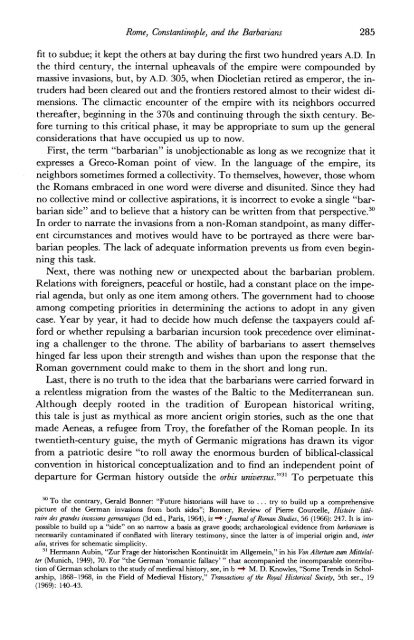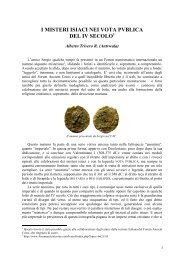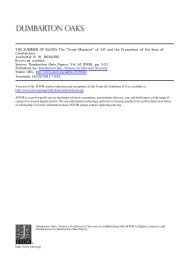Rome, Constantinople, and the Barbarians - Constantine the Great
Rome, Constantinople, and the Barbarians - Constantine the Great
Rome, Constantinople, and the Barbarians - Constantine the Great
Create successful ePaper yourself
Turn your PDF publications into a flip-book with our unique Google optimized e-Paper software.
<strong>Rome</strong>, <strong>Constantinople</strong>, <strong>and</strong> <strong>the</strong> <strong>Barbarians</strong> 285<br />
fit to subdue; it kept <strong>the</strong> o<strong>the</strong>rs at bay during <strong>the</strong> first two hundred years A.D. In<br />
<strong>the</strong> third century, <strong>the</strong> internal upheavals of <strong>the</strong> empire were compounded by<br />
massive invasions, but, by A.D. 305, when Diocletian retired as emperor, <strong>the</strong> intruders<br />
had been cleared out <strong>and</strong> <strong>the</strong> frontiers restored almost to <strong>the</strong>ir widest dimensions.<br />
The climactic encounter of <strong>the</strong> empire with its neighbors occurred<br />
<strong>the</strong>reafter, beginning in <strong>the</strong> 370s <strong>and</strong> continuing through <strong>the</strong> sixth century. Before<br />
turning to this critical phase, it may be appropriate to sum up <strong>the</strong> general<br />
considerations that have occupied us up to now.<br />
First, <strong>the</strong> term "barbarian" is unobjectionable as long as we recognize that it<br />
expresses a Greco-Roman point of view. In <strong>the</strong> language of <strong>the</strong> empire, its<br />
neighbors sometimes formed a collectivity. To <strong>the</strong>mselves, however, those whom<br />
<strong>the</strong> Romans embraced in one word were diverse <strong>and</strong> disunited. Since <strong>the</strong>y had<br />
no collective mind or collective aspirations, it is incorrect to evoke a single "barbarian<br />
side" <strong>and</strong> to believe that a history can be written from that perspective.30<br />
In order to narrate <strong>the</strong> invasions from a non-Roman st<strong>and</strong>point, as many different<br />
circumstances <strong>and</strong> motives would have to be portrayed as <strong>the</strong>re were barbarian<br />
peoples. The lack of adequate information prevents us from even beginning<br />
this task.<br />
Next, <strong>the</strong>re was nothing new or unexpected about <strong>the</strong> barbarian problem.<br />
Relations with foreigners, peaceful or hostile, had a constant place on <strong>the</strong> imperial<br />
agenda, but only as one item among o<strong>the</strong>rs. The government had to choose<br />
among competing priorities in determining <strong>the</strong> actions to adopt in any given<br />
case. Year by year, it had to decide how much defense <strong>the</strong> taxpayers could afford<br />
or whe<strong>the</strong>r repulsing a barbarian incursion took precedence over eliminating<br />
a challenger to <strong>the</strong> throne. The ability of barbarians to assert <strong>the</strong>mselves<br />
hinged far less upon <strong>the</strong>ir strength <strong>and</strong> wishes than upon <strong>the</strong> response that <strong>the</strong><br />
Roman government could make to <strong>the</strong>m in <strong>the</strong> short <strong>and</strong> long run.<br />
Last, <strong>the</strong>re is no truth to <strong>the</strong> idea that <strong>the</strong> barbarians were carried forward in<br />
a relentless migration from <strong>the</strong> wastes of <strong>the</strong> Baltic to <strong>the</strong> Mediterranean sun.<br />
Although deeply rooted in <strong>the</strong> tradition of European historical writing,<br />
this tale is just as mythical as more ancient origin stories, such as <strong>the</strong> one that<br />
made Aeneas, a refugee from Troy, <strong>the</strong> forefa<strong>the</strong>r of <strong>the</strong> Roman people. In its<br />
twentieth-century guise, <strong>the</strong> myth of Germanic migrations has drawn its vigor<br />
from a patriotic desire "to roll away <strong>the</strong> enormous burden of biblical-classical<br />
convention in historical conceptualization <strong>and</strong> to find an independent point of<br />
departure for German history outside <strong>the</strong> orbis universus."31 To perpetuate this<br />
30To <strong>the</strong> contrary, Gerald Bonner: "Future historians will have to . . . try to build up a comprehensive<br />
picture of <strong>the</strong> German invasions from both sides"; Bonner, Review of Pierre Courcelle, Histoire littiraire<br />
des gr<strong>and</strong>es invasions gennaniques (3d ed., Paris, 1964), in <strong>the</strong>Joumal of Roman Studies, 56 (1966): 247. It is impossible<br />
to build up a "side" on so narrow a basis as grave goods; archaeological evidence from barbaricum is<br />
necessarily contaminated if confiated with literary testimony, since <strong>the</strong> latter is of imperial origin <strong>and</strong>, inter<br />
alia, strives for schematic simplicity.<br />
3' Hermann Aubin, "Zur Frage der historischen Kontinuitat im Allgemein," in his Von Altertum zum Mittelalter<br />
(Munich, 1949), 70. For "<strong>the</strong> German 'romantic fallacy'" that accompanied <strong>the</strong> incomparable contribution<br />
of German scholars to <strong>the</strong> study of medieval history, see, in brief, M. D. Knowles, "Some Trends in Scholarship,<br />
1868-1968, in <strong>the</strong> Field of Medieval History," Transactions of <strong>the</strong> Royal Historical Society, 5th ser., 19<br />
(1969): 140-43.







